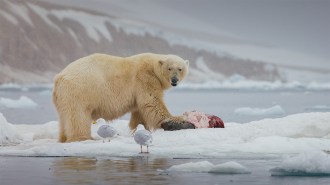IPCC’s Himalayan glacier ‘mistake’ not an accident
Newspaper reports that unsubstantiated numbers were used intentionally
A London newspaper reports today that the unsubstantiated Himalayan-glacier melt figures contained in a supposedly authoritative 2007 report on climate warming were used intentionally, despite the report’s lead author knowing there were no data to back them up.
Until now, the organization that published the report – the Nobel Prize-winning Intergovernmental Panel on Climate Change – had argued the exaggerated figures in that report were an accident: due to insufficient fact checking of the source material.
Uh, no. It now appears the incident wasn’t quite that innocent.
The Sunday Mail’s David Rose reached Murari Lal, the coordinating lead author of the 2007 IPCC report’s chapter on Asia. Lal told Rose that he knew there were no solid data to support the report’s claim that Himalayan glaciers – the source of drinking and irrigation water for downstream areas throughout Asia – could dry up by 2035. Said Lal: “We thought that if we can highlight it, it will impact policy makers and politicians and encourage them to take some concrete action.” In other words, Rose says, Lal “last night admitted [the scary figure] was included purely to put political pressure on world leaders.”
A noble motive, perhaps, but totally inexcusable.
Science collects lots of tidbits – data, factoids, apparent correlations, syntheses of trends and more. The whole purpose of peer review is to limit the likelihood that biases, misinterpretations and outright errors of fact are sanctified as real. Peer review can’t eliminate errors and bias, but it works hard to minimize the chance that they will creep into the “knowledge base” that guides further research and political action.
The IPCC report was supposed to reflect only peer-reviewed science. Not the speculation of scientists, which the initial source of that 2035 figure (Indian glaciologist Syed Hasnain) recently acknowledged it was. Nor should magazine articles or gray literature reports – like the World Wildlife Fund document that repeated the speculative 2035 figure – become the foundation for IPCC conclusions. Which is why IPCC specifically prohibits reliance on such documents.
If Lal knowingly perpetuated unsubstantiated speculation in a purportedly authoritative document, that would constitute what we in journalism refer to as a “hanging offense” – the kind of action that gets you fired or at least heavily sanctioned. Moreover, the new Rose story also charges that the “WWF article [from which the 2035 date was picked up] also contained a basic error in its arithmetic. A claim that one glacier was retreating at the alarming rate of 134 metres a year should in fact have said 23 metres.” Oops.
The Rose article also charges that Lal’s committee didn’t investigate challenges to glacier data in its chapter — challenges made by climate scientists prior to the IPCC report’s publication.
I’ll be the first to acknowledge that I don’t know for certain what Lal and his team did or didn’t do. Journalism is not peer review. But our reporting can help policy makers and scientists know where further investigation is warranted. And it’s warranted here.
If further investigation confirms that what Rose reported today is true, then Lal – and, through him, the IPCC – would have abrograted the public trust. And stupidly given ammunition to those who have made a sport of challenging solid climate science.
Glaciers globally are melting. In some cases, precipitously. And people living downstream are already not only seeing but also feeling the effects. How bad the situation is needs further study. Soon. Not the scoff of people who challenge the idea of global warming because it may be politically, intellectually or economically inconvenient.
At the United Nations Climate Change meeting in Copenhagen, last month, IPCC chairman R.K. Pachauri noted that the next wholesale assessment of climate data and projections – a follow-up to IPCC’s 2007 Fourth Assessment report – is now underway.
Let’s hope Pachauri and the rest of the IPCC respond to the Himalayan glacier fiasco and explain promptly how they plan to safeguard the new review from attempts by scientists to seed it with similar well-meaning but ill-conceived conclusions. Non-peer-reviewed conclusions that undermine – perhaps disastrously – the credibility of IPCC and climatology generally.






